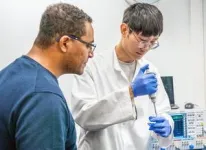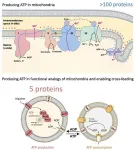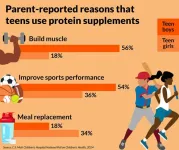(Press-News.org) A new study1 has unveiled the Hispanic Thrifty Food Plan (H-TFP), a culturally adapted and affordable diet specifically designed to align with the eating habits of U.S. Hispanic households. The research, led by Adam Drewnowski, PhD, from the University of Washington, used advanced dietary modeling to create a version of the USDA’s Thrifty Food Plan (TFP) that respects the distinctive food patterns of Hispanic communities.
The USDA's Thrifty Food Plan is the foundation for setting benefits under the Supplemental Nutrition Assistance Program (SNAP), but it has not traditionally accounted for the dietary diversity of specific population groups. The H-TFP is a cost-neutral alternative that remains consistent with USDA dietary guidelines and is adapted to Hispanic preferences, including higher intakes of pork, beans, whole grains, and 100% fruit juice. This approach ensures the H-TFP meets the nutritional needs of Hispanic families without increasing weekly food costs, maintaining a budget of $186 per week for a family of four.
Key Insights
Hispanic households in the study, despite facing lower average incomes and education levels, demonstrated equal or higher diet quality than non-Hispanic groups, as measured by the Healthy Eating Index (HEI-2015). Hispanic participants consumed more beans, fruit juices, soups, and grain-based dishes while having lower intakes of pizza, candy, and desserts. Researchers believe this study supports the potential for adapting the Thrifty Food Plan to better fit the cultural and dietary habits of this growing population group.
Adam Drewnowski, co-author of the study and Director of the Center for Public Health Nutrition at the University of Washington, emphasized the significance of culturally relevant diets, saying, "Culturally tailored food plans like the H-TFP help ensure that diverse communities can maintain healthy diets that reflect their food traditions, without sacrificing affordability or nutrition. This model shows that we can preserve cultural food preferences while promoting healthy eating at the same cost as the USDA's Thrifty Food Plan."
The new H-TFP market basket featured more whole grains, more fresh pork, and less poultry, compared to the previously published TFP for the US population.2
Benefits to Hispanic Households
The H-TFP is a model that emphasizes the importance of culturally appropriate diets. It aims to respect traditional Hispanic eating patterns while adhering to established nutritional guidelines. The model is also designed to be cost-neutral with respect to the existing USDA TFP. Calculations of lowest cost healthy diets ensure that families can follow a healthy diet within their budget constraints.
According to Drewnowski, the H-TFP demonstrates how food programs can be designed to meet the needs of culturally diverse populations in the U.S. "We believe this research highlights the value of offering flexible food plans that can help Hispanic families continue enjoying culturally significant meals while also following a nutritionally balanced diet," added Drewnowski.
Model Insights
Two versions of the H-TFP were developed: one including pork as a protein source, and another where pork replaced both beef and poultry. Both models were able to satisfy all nutritional requirements without exceeding cost limits. However, a vegetarian version of the H-TFP was found to be infeasible for most age and gender groups, as it could not meet energy and nutrient requirements without surpassing the budget.
About the Study
This study was conducted by Adam Drewnowski at the Center for Public Health Nutrition at the University of Washington, and Romane Poinsot and Matthieu Maillot at MS-Nutrition based in Marseille, France. The research was funded by the National Pork Board.
About National Pork Board
The National Pork Board has responsibility for Pork Checkoff-funded research, promotion and consumer information projects and for communicating with pork producers and the public. The Pork Checkoff funds national and state programs in consumer education and marketing, retail and foodservice marketing, export market promotion, production improvement, science and technology, swine health, pork safety, and environmental management and sustainability. For the past half century, the U.S. pork industry has delivered on its commitment to sustainable production and has made significant strides in reducing the environmental impact of pig farming. Through a legislative national Pork Checkoff, pork producers invest $0.35 for each $100 value of hogs sold. Importers of pork products contribute a like amount, based on a formula. For information on Checkoff-funded programs, pork producers can call the Pork Checkoff Service Center at (800) 456-7675 or visit www.pork.org.
References
Poinsot R, Maillot M, Drewnowski A. Hispanic Thrifty Food Plan (H-TFP): Healthy, affordable, and culturally relevant. Nutrients. 2024;16(17):2915.
Poinsot R, Maillot M, Drewnowski A. Fresh pork as protein source in the USDA Thrifty Food Plan 2021: A modeling analysis of lowest-cost healthy diets. Nutrients. 2023;15(8):1897. END
First ever Hispanic thrifty food plan published
2024-10-21
ELSE PRESS RELEASES FROM THIS DATE:
Study reveals how fear memories transform over time, offering new insights into PTSD
2024-10-21
An innovative study, to be published in Nature Communications on October 21, 2024, reveals the mechanism behind two seemingly contradictory effects of fear memories: the inability to forget yet the difficulty to recall. Led by researchers from Sony Computer Science Laboratories, Inc., ATR Computational Neuroscience Laboratories, and the University of Tokyo, the study shows how fear experiences are initially remembered as broad, associative memories, but over time become integrated into episodic memories with a more specific timeline.
The researchers conducted experiments using functional ...
New guideline: Preventing a first stroke may be possible with screening, lifestyle changes
2024-10-21
Guideline Highlights:
Each year in the U.S., over half a million people have a first stroke; however, up to 80% of strokes may be preventable.
The new primary prevention of stroke guideline from the American Stroke Association urges health care professionals to screen people for stroke risk factors, including high blood pressure, elevated cholesterol, high blood sugar and obesity.
Increasing public awareness and knowledge about healthy lifestyle changes, such as smoking cessation, increased physical activity, improved dietary habits and better sleep, may also help people reduce their stroke risk.
The new guideline highlights the American Heart ...
Creating a simplified form of life
2024-10-21
It is one of the most fundamental questions in science: how can lifeless molecules come together to form a living cell? Bert Poolman, Professor of Biochemistry at the University of Groningen, has been working on this problem for over twenty years. He aims to understand life by trying to reconstruct it; he is building simplified artificial versions of biological systems that can be used as components for a synthetic cell. Poolman recently published two papers in Nature Nanotechnology and Nature Communications. In the first paper, he describes a system for energy conversion ...
Large-scale study of brain volume finds genetic links to Parkinson’s disease and ADHD
2024-10-21
In one of the largest-ever studies of DNA and brain volume, researchers have identified 254 genetic variants that shape key structures in the “deep brain,” including those that control memory, motor skills, addictive behaviors and more. The findings were just published in the journal Nature Genetics.
The study is powered by the Enhancing Neuro Imaging Genetics through Meta-Analysis (ENIGMA) consortium, an international effort based at the Keck School of Medicine of USC, which unites more than 1,000 research labs across 45 countries to hunt for genetic variations that affect the brain’s structure and function.
“A lot of brain diseases are known to be partially ...
Understanding the relationship between food waste, climate change, and aging population
2024-10-21
Food production is one of the pillars of human civilization and underlies many of the changes caused by humans on planet’s landscapes. Producing food and getting it to people’s plates entails a significant expenditure of energy and resources. Unfortunately, approximately one third of all food produced globally is not consumed and discarded. Hence, to build sustainable societies, it is essential to minimize food waste.
In Japan, based on estimates reported by governmental institutions, an astonishing 2.47 megatons of food waste was generated in ...
Can aerobic exercise help prevent brain fog caused by chemotherapy?
2024-10-21
Many women who receive chemotherapy experience a decreased ability to remember, concentrate, and/or think—commonly referred to as “chemo-brain” or “brain fog”—both short- and long-term. In a recent clinical trial of women initiating chemotherapy for breast cancer, those who simultaneously started an aerobic exercise program self-reported greater improvements in cognitive function and quality of life compared with those receiving standard care. The findings are published by Wiley online in CANCER, a peer-reviewed journal of the American Cancer Society.
The study, called the Aerobic exercise and ...
National poll: Many teens use protein supplements for muscle growth, sports performance
2024-10-21
ANN ARBOR, Mich. – Protein bars, shakes and powders are increasingly popular among adults – but many teens may be jumping on the bandwagon too.
Two in five parents say their teen consumed protein supplements in the past year, according to the University of Michigan Health C.S. Mott Children’s Hospital National Poll on Children’s Health. The trend was more common among teen boys who were also more likely to take protein supplements every day or most days, parents reported.
“Protein is part of a healthy diet but it can be hard for parents to tell if ...
Dr. Stephanie Knatz Peck: Revolutionizing eating disorder treatment with psychedelic research
2024-10-21
SAN DIEGO, California, 21 October 2024. In an illuminating Genomic Press Interview published today, Dr. Stephanie Knatz Peck, Associate Clinical Professor of Psychiatry at the University of California, San Diego (UCSD), unveils her groundbreaking work in eating disorder treatment and psychedelic research. The interview, featured in the journal Psychedelics, offers an intimate look at Dr. Knatz Peck's journey from personal struggle with an eating disorder to becoming a leading innovator in the field.
Dr. Knatz Peck's research ...
Male flies with shorter eyestalks make up for being less attractive by fighting more fiercely
2024-10-21
In stalk-eyed flies, longer eyestalks attract the ladies. Females prefer males with longer eyestalks, and other males are less likely to fight them for access to females. But some males have a copy of the X chromosome which always causes short eyestalks. Scientists investigating why this mutation hasn’t died out, despite sexual selection, have discovered that the flies could be compensating for their shorter eyestalks with increased aggression.
“It's the first time I'm aware of that there's ...
Light-AI technology opens the door to early cancer diagnosis
2024-10-21
A research team led by Dr. Ho Sang Jung of the Advanced Bio and Healthcare Materials Research Division at the Korea Institute of Materials Science has developed an innovative sensor material that amplifies the optical signals of cancer metabolites in body fluids (saliva, mucus, urine, etc.) and analyzes them using artificial intelligence to diagnose cancer.
This technology quickly and sensitively detects metabolites and changes in cancer patients' body fluids, providing a non-invasive way to diagnose cancer instead of traditional blood draws or biopsies. In collaboration with Professor Soo Woong ...








